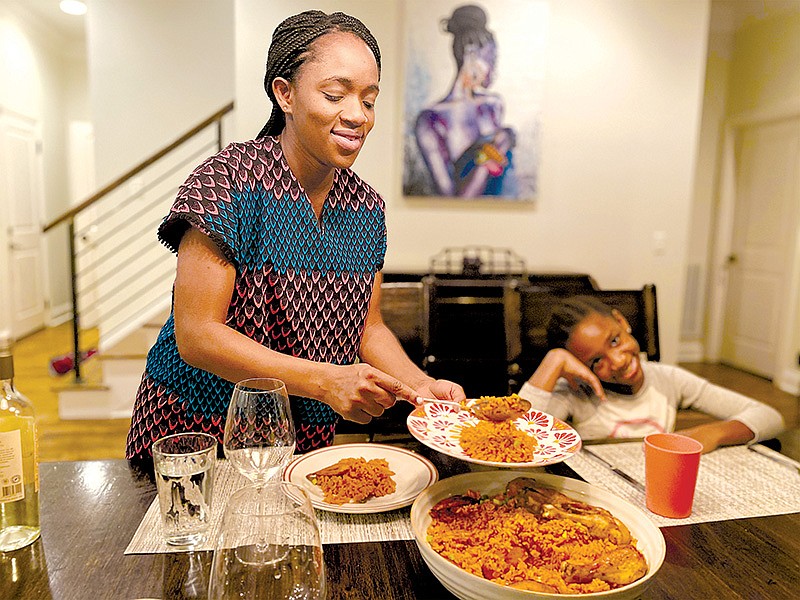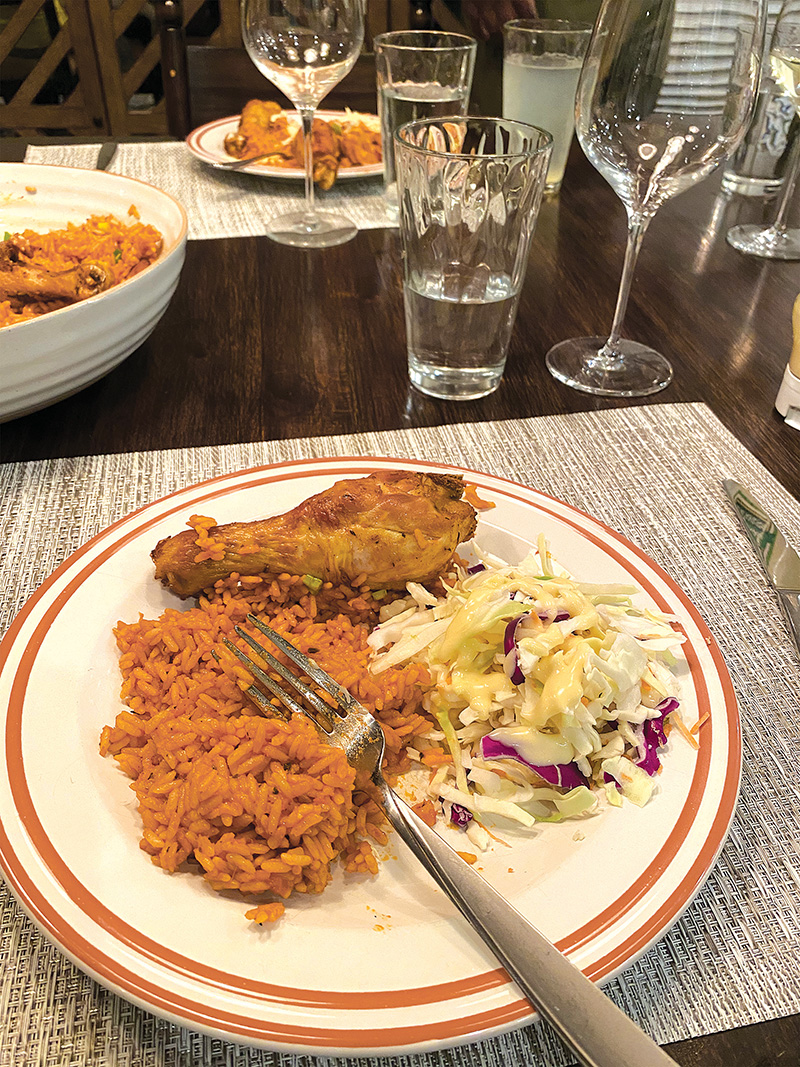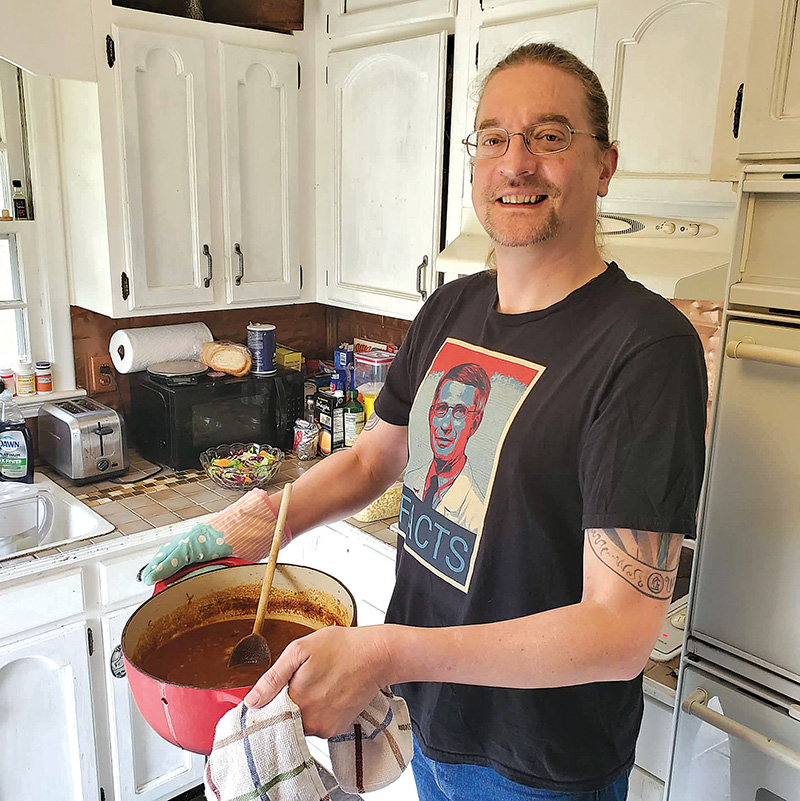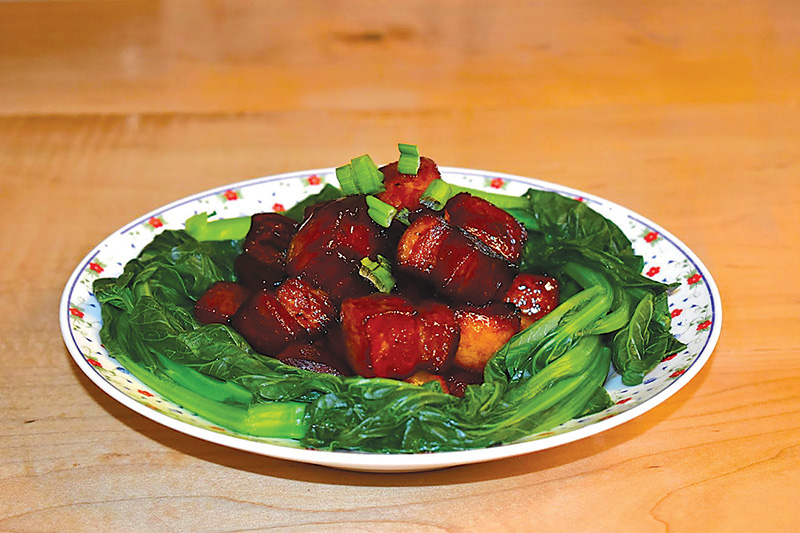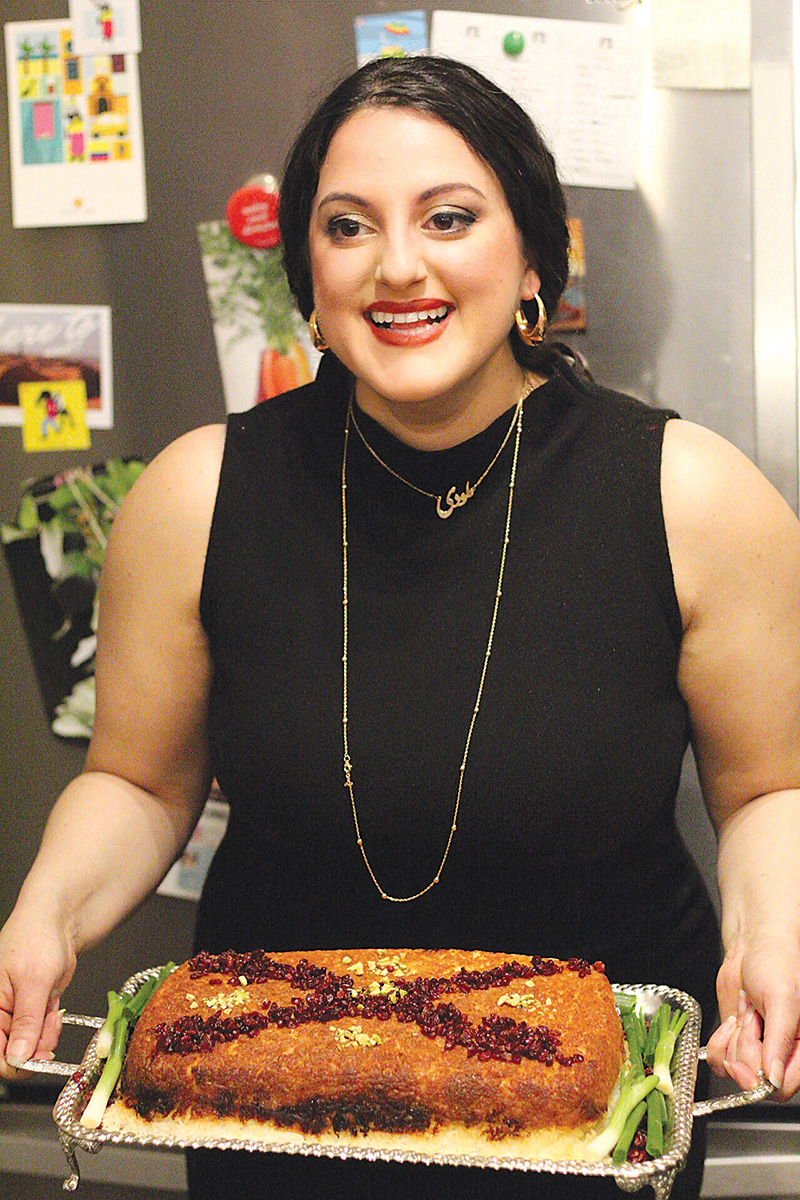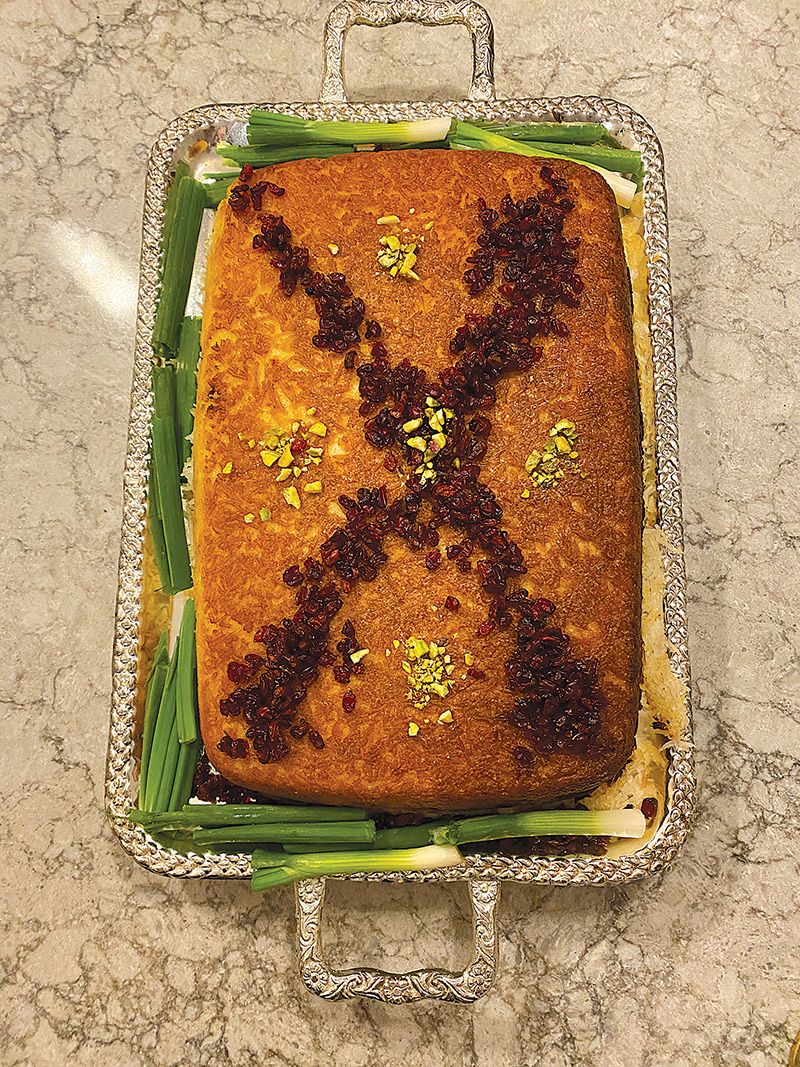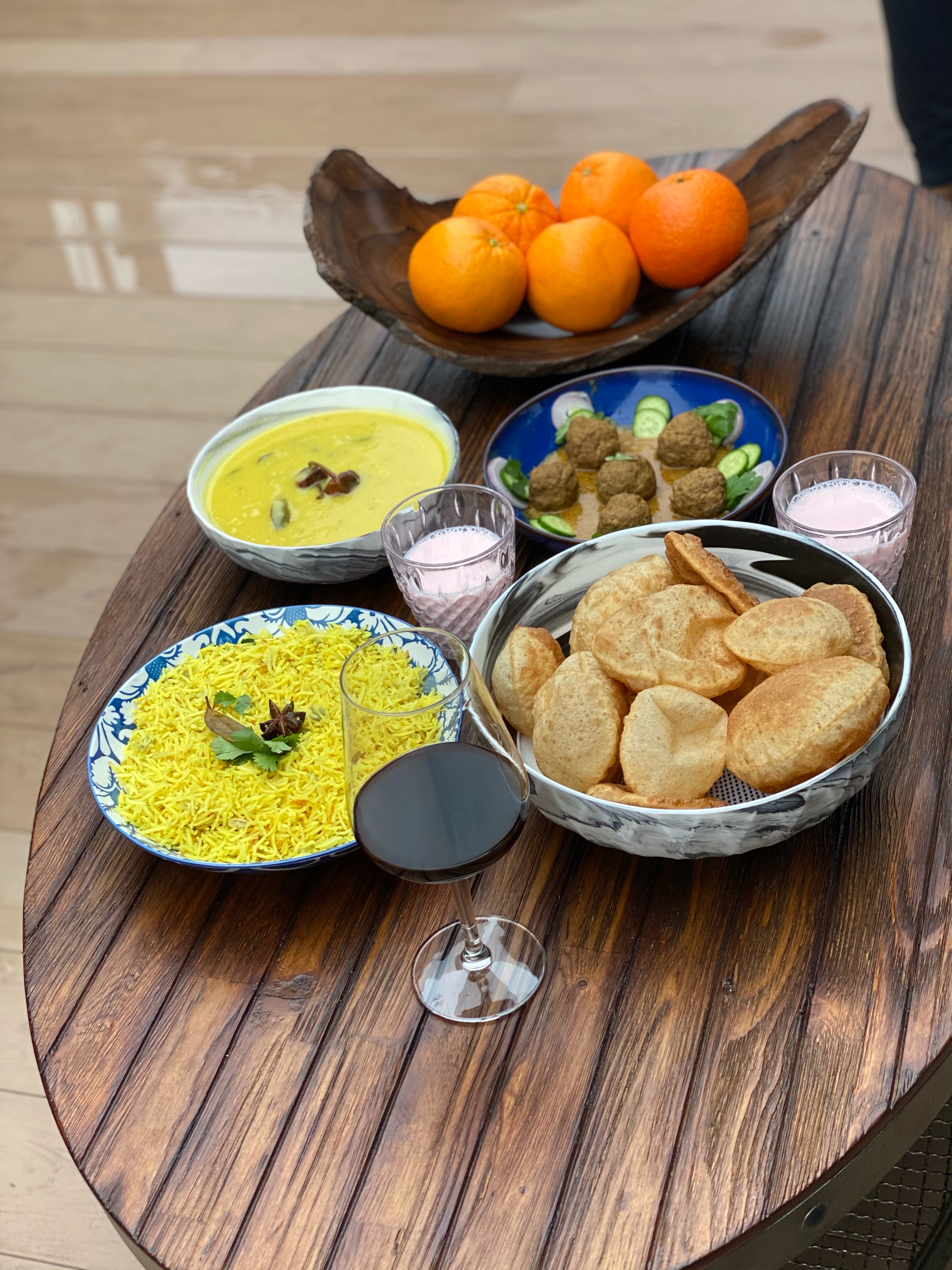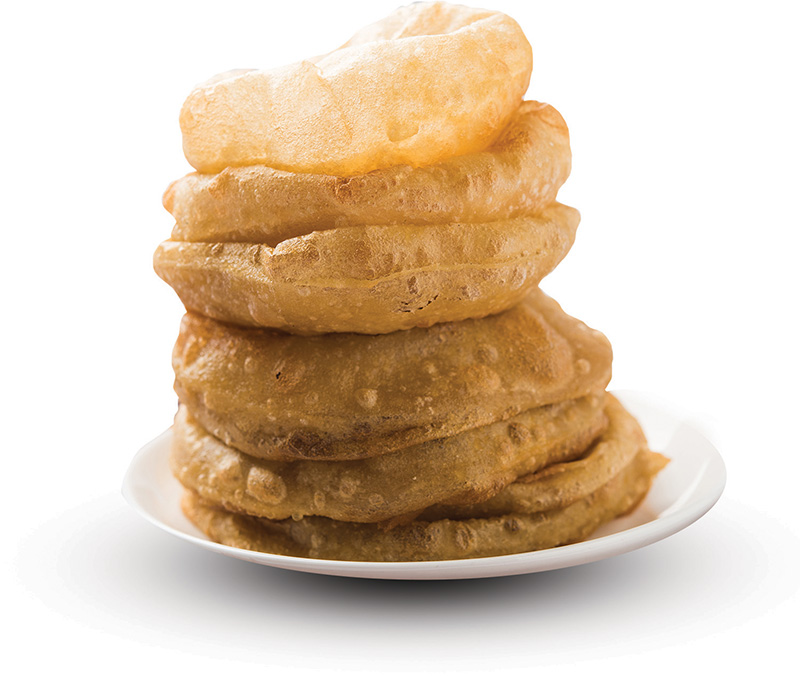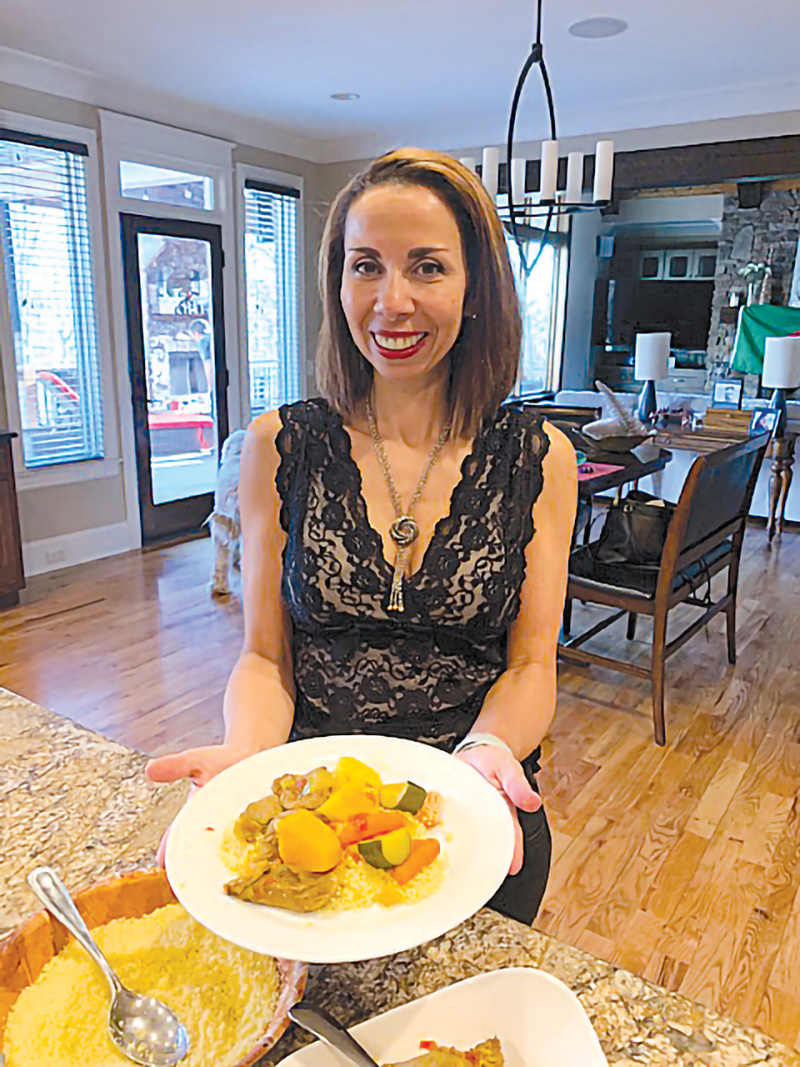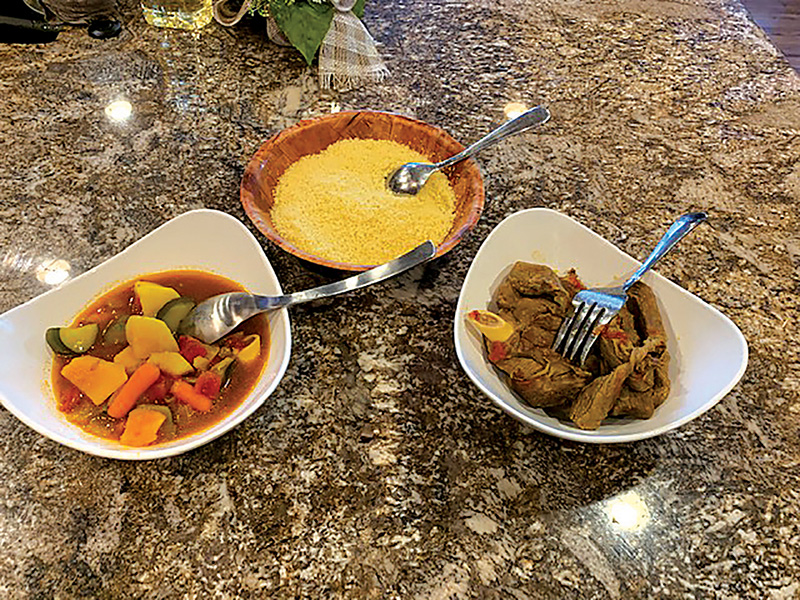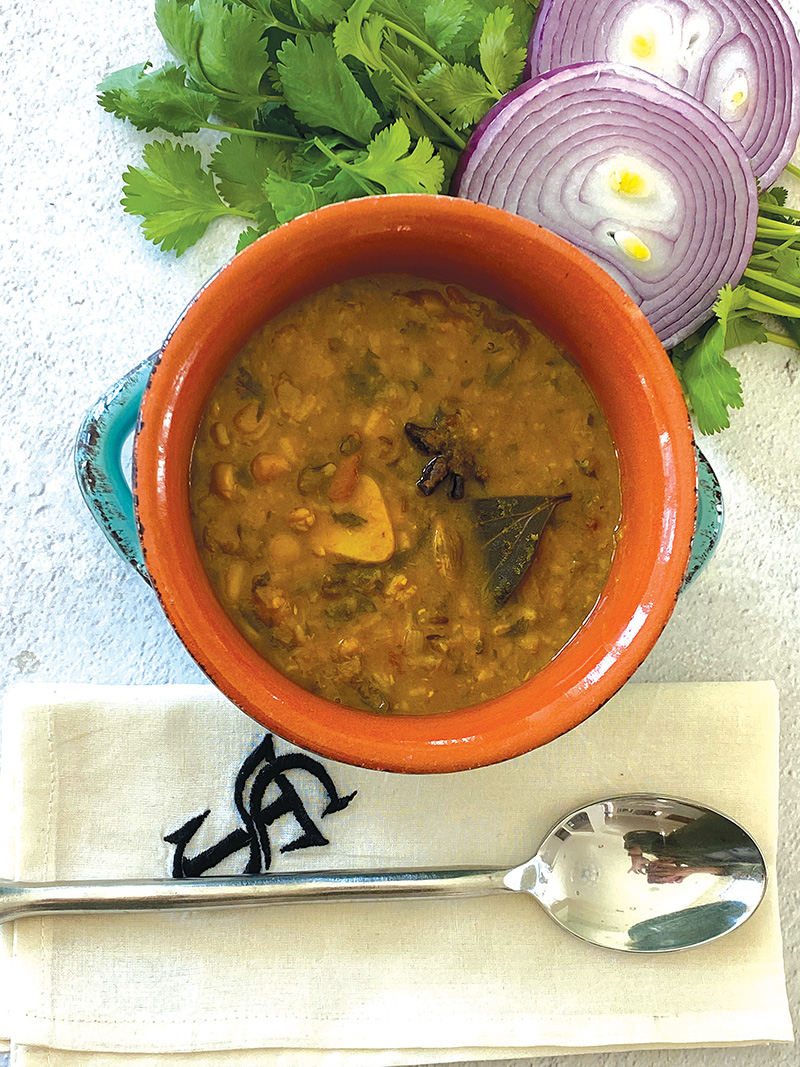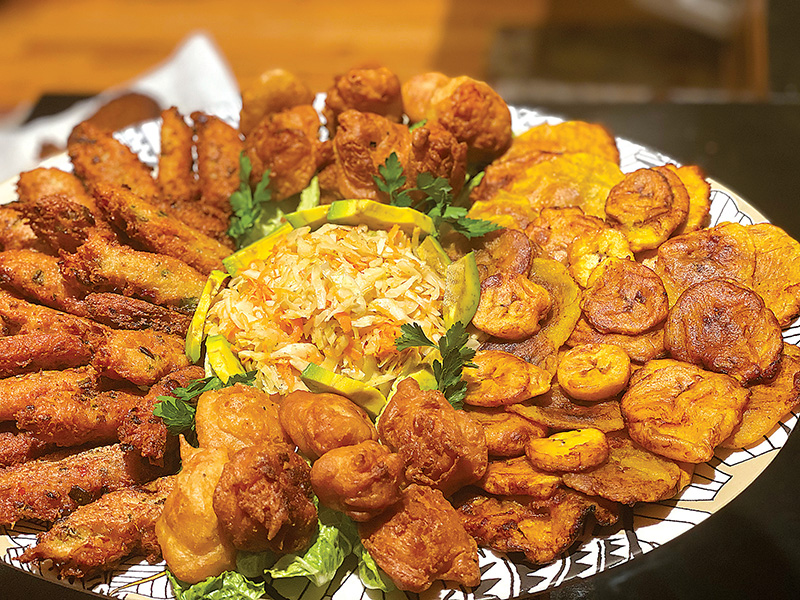If you were to pick a dish to make for friends and/or family that best reflected your roots, what would you make?
As for me, I'm Jewish, with a mom from New York's upper west side, a dad from right here in Chattanooga and grandparents by way of Russia. So I might host you for a Passover Seder and serve my mother's oven-roasted chicken with matzo meal stuffing, some of which would come out of the oven deliciously clumped together and some of which would be toasted to crunchy, greasy perfection. Or maybe you'd come for a first-night Chanukah meal, at which time I would spend an inordinate amount of time looking for a box potato grater that I may or may not own so I could fry up some crunchy on the outside, soft on the inside sweet-potato latkes.
With so many more people cooking at home during the pandemic, we decided to see what signature dishes our neighbors from a variety of cultural backgrounds might whip up for their friends and family. Read on for a glimpse into meals from across the globe, and perhaps a little inspiration to try something different in your own kitchen.
Amanda Okafor of Nigeria
Amanda Okafor has a busy life as a pharmacist, owner of online Nigerian grocery store OsiAfrik.com and mom of four children under the age of 10, including a newborn. Originally from Nigeria, she came to the U.S. 20 years ago to attend the University of Incarnate Word in San Antonio, Texas, and later moved with her husband, a urologist, to Chattanooga.
Even with everything she does, she found some time to whip up her favorite west Nigerian staple, jollof rice, and to share photos of the process for us here at Chatter.
"I chose to cook jollof rice (also known as "party jollof") because I love getting together with friends and family, and there is no party in Nigeria without it," she says.
Every West African country has its own take on jollof rice, explains Okafor. "In fact, there is a friendly rivalry among these countries over whose jollof rice is the best. This is known as Africa's famous 'jollof rice wars.'"
Nigerian jollof rice
What you need:
500 grams long-grain white rice
2 medium white onions
4 Roma tomatoes
4 red bell peppers
1 habanero
1/2 teaspoon thyme
3 bay leaves
1 tablespoon jollof spice mix
2 Knorr stock cubes
150 milliliters chicken stock
Salt to taste
1/4 cup peanut or vegetable oil
What you do:
1. Chop one onion. Blend together tomatoes, bell peppers, habanero and other onion.
2. Parboil rice for about 14 minutes and drain.
3. Heat peanut or vegetable oil. Add chopped onion and thyme and cook, stirring, for 2 minutes.
4. Add blended tomato mix and bay leaves. Cook for 15 minutes on low to medium heat.
5. Add jollof spice mix and stock cubes. Let simmer for about 5 minutes.
6. Add parboiled rice to tomato mix. Add chicken stock and 150 milliliters of water. Cook on low heat for 15-20 minutes, or until rice is cooked. Serve and enjoy.
*Cook's note: I served mine with oven-baked chicken and fried plantains. To prepare the plantains, slice 2 ripe plantains, toss them in 1/4 teaspoon salt, then deep-fry until golden brown.
Dominik Heinrici of Austria
When he was 14 years old, Dominik Heinrici's mother told him, "Son, if you can't do your own laundry, and even more importantly, cook, I'll never respect you as a man."
And so, under her tutelage in his hometown of Salzburg, Austria, young Dominik learned to cook.
"Before WWI, the Austro-Hungarian Hapsburg Empire was one of the largest in Europe," says Heinrici. "Although the empire no longer exists and Austria is a tiny country, the cuisine is extremely diverse, combining the most delicious cooking traditions of the German people, Eastern Europe, the Mediterranean and the Balkans."
Heinrici came to the U.S. in 2012 and was a German instructor at Ohio University before coming to Chattanooga. He now teaches First Year English, Contemporary Grammar, and History of the English Language at UTC. His wife, Sarah Einstein, is a UTC professor as well.
For this Chatter challenge, Heinrici made Austrian goulash.
"Goulash reminds me of my old home country and my mother. I really enjoy cooking this dish with Sarah, who contributes the 'nockerln' (which Americans would call spaetzle)," he says.
Oh, and yes, he can also do his own laundry.
Austrian goulash
What you need:
2 pounds pre-cut beef stew meat
> "It should not be too lean because the fat carries the flavor."
2 pounds yellow onions
> "The secret of a good goulash is the meat/onion ratio being 1:1."
Hungarian-style sweet paprika
> "Many Asian grocery stores carry the nice stuff imported from Europe."
A little red wine
1 box beef bone stock
Salt and pepper, to taste
1 lemon
1-2 tablespoons tomato paste
Butter, oil
What you do:
1. Dice onions into very fine cubes. Add oil and butter to Dutch oven and brown the onions. Immediately add a tablespoon or two of paprika.
2. Add beef and fry it quickly at a high temperature. When the meat is nicely browned, add some red wine and let reduce for some time.
3. Add beef stock, salt, pepper and more paprika. How much is entirely up to the cook and how spicy they want their goulash to be. I recommend going light at first. You can always add more later. Paprika can be very overpowering.
4. Add juice of freshly squeezed lemon and 1-2 tablespoons tomato paste. Bring to a boil, then immediately turn heat down to a low simmer and let cook for at least 3-5 hours, stirring regularly and adding water if needed. The magic lies in the time you allow it to stew. This is the best way to get the beef super-tender and delicious.
* Cook's note: This amount of goulash should easily feed 4-6 people. I make the same amount for just my wife and me, because my grandmother taught me that this is the right way. Be it superstition or not, who am I to contradict my gran? Also, stirring a big pot is a sensual delight. It is common Austrian wisdom that goulash is best one day later when you reheat it anyway. Otherwise, it's a perfect food to keep in your freezer when you need a quick meal to serve over noodles.
How to say “bon appetit” in:
Nigeria: Rie nke ọmaAlbania: Të bëftë mireChina: Qǐng xiǎngyòngHaiti: Bon apetiIran: Nooshe jânAustria: Guten appetitIndia: Kripyā bhojan kā ānnaṅd lijīyai
Chen Zhang of southern China
Chen Zhang was born in Wuhan in central China, and then moved to Haikou in the Hainan province of southern China. His family came to New York when he was 9 years old. After earning a Master of Public Health degree at the University of North Carolina, Zhang moved to Chattanooga, where he is a researcher for BlueCross and his wife is a preschool teacher at Little Miss Mag.
For our Chatter challenge, Zhang chose to make hong shao rou: literally, red braised pork.
"Hong shao rou is a Chinese home-style dish traditionally originating from the Shanghai area but popular across many regions of China," Zhang says.
The dish features pork belly braised with a base of classic Chinese spices, soy sauce and sugar, which gives the dish a sweet and succulent flavor and its distinctive red sheen.
"I grew up in China eating this dish made by my grandma, uncle and my mom, and it is one of my comfort foods," he says. "In fact, one version (spiced with Chinese chilies) is well known for being one of Chairman Mao's favorite dishes and can be found in many restaurants."
Hong shao rou
What you need:
800 grams pork belly, cut into 1 1/2-inch cubes
30 grams ginger, sliced
45 grams sugar
15 grams star anise
25 grams soy sauce
30 grams cooking wine (Shaoxing wine)
1 bay leaf
50 grams scallions, cut into 3-inch sections
3 grams cinnamon sticks
Salt, to taste
15 grams cooking oil
For the garnish:
5 grams scallion greens, finely chopped
250 grams choy sum (Cantonese cabbage)
What you do:
1. Fill a pot with tap-temperature water, pork belly and three slices of ginger (about 10 grams). Bring to a boil and blanch for 5 minutes. Remove cooked pork belly for later use. Dispose of water and cooked ginger.
2. Cook sugar and star anise in oil. Saute on medium heat until sugar melts and turns medium brown. Do not burn the sugar.
3. Once melted sugar turns medium brown, add cooked pork belly pieces and continue sauteing on medium heat until surface moisture on the pork has mostly evaporated but meat is not charred. The pork belly should sizzle slightly.
4. Add soy sauce and cooking wine and continue sauteing on medium heat until sauce thickens and covers pork belly pieces.
5. Once each pork belly piece has been well coated, add remaining ginger, bay leaf, scallions and cinnamon. Add water to cover and braise on medium heat for 30-40 minutes. Leave the lid on but allow for some steam to escape.
6. In the meantime, blanch choy sum.
7. Once most of the liquid has evaporated from main dish, remove cooked ginger, bay leaf, scallions, star anise and cinnamon. Continue cooking until surface moisture is mostly gone and the sauce coats each piece of pork belly.
8. Salt to taste, then plate with scallion greens and choy sum as garnish and enjoy.
Melody Shekari of Iran
Melody Shekari is a local attorney who runs her own firm. Born to parents who emigrated from Tehran, Iran, to the U.S. - her father in the 1970s and her mother in the late 1980s - she herself was born in Bay City, Texas, and moved with her family to Chattanooga in 1983 when her father took a job with TVA. While school and travels took her to Boston, Iran, Seattle and Los Angeles, she returned to Chattanooga after 10 years away, and has since gotten very involved with the community and with local politics.
But she has remained loyal to her roots, and for this Chatter challenge prepared tahchin morgh, essentially an Iranian chicken-and-rice cake.
"I love Persian food, and I love that my house smells like my mother's cooking, full of spices and herbs, when I cook," Shekari says. "And I now appreciate the cooking of my mother and grandmother much more, because Persian cooking is very time consuming! Rice is central to Persian cooking, as well as chicken, beef kebabs and stews (called khoreshes), and each of these takes hours to prepare and cook. I like to think that that is why it is such a crowd-pleaser and it tastes so good."
A few years ago, Shekari convinced her mother to host a Persian New Year event in Chattanooga, and ended up maxing out the 200-plus-capacity venue. It became a community tradition, until COVID-19 hit and they could no longer do it.
"Persian food is flavorful but mild - no really spicy foods - and it was a great way to connect with people who may not know a lot about Iran or Persian people other than what they see on the news," says Shekari, who hopes to bring the springtime event back to Chattanooga next year.
Tahchin morgh
What you need:
3 cups white basmati rice
Salt (a lot)
1/4 teaspoon saffron
3 tablespoons olive oil
1 large onion, sliced
4 garlic cloves, minced
2 pounds boneless, skinless chicken thighs, halved
1/4 teaspoon black pepper
1/4 cup lemon juice
1 cup plain Greek yogurt
1 egg
5 tablespoons unsalted butter
For barberry topping (optional):
1/2 cup dried barberries
Honey to taste
Crushed pistachios
What you do:
1. Put rice in a large bowl and cover with water. Mix the rice with your hands to wash it, then drain. Repeat for a total of five times. Put rice in a bowl with 2 cups cold water and 2 tablespoons salt, stir, and let sit for at least 1 hour.
2. In a small bowl, add saffron to 2 tablespoons hot water.
3. Heat olive oil in a large saute pan over medium heat, then add onion and 1/4 teaspoon salt. Cook for 20 minutes, stirring occasionally. Add garlic and cook 2 minutes.
4. Add chicken thighs, 2 tablespoons salt and black pepper. Make sure the onion and garlic don't burn by moving them around and on top of chicken. Turn chicken and cook until slightly brown, 6-10 minutes.
5. Add lemon juice and saffron water, mixing well. Lower heat to medium-low and partially cover pot. Cook for 20 minutes, stirring occasionally.
6. While chicken is simmering, set oven rack to lowest position and preheat to 400 Fahrenheit. Parboil the rice: In a large nonstick pot, bring 12 cups water to boil over high heat. Add 1/4 cup salt. Drain rice and add to pot and stir. Watch the rice. Keep a bowl and towels nearby and spoon foam into it. It will likely overflow, just be careful not to burn yourself. As soon as rice starts popping up, set a 4-minute timer and put a strainer for the rice in the sink. (You may need two strainers for this amount of rice.) After 4 minutes, take a little rice and test it. When the rice is tender with a little bite, drain and rinse with spray faucet until rice stops steaming.
7. Remove chicken from heat and put it on a cutting board. Using a knife and/or fork, cut into strips and pieces. Return to pan and coat in juices.
8. In a large bowl, combine yogurt, egg and a tiny pinch of ground saffron. Add half the parboiled rice and mix together well.
9. Coat a 9-by-13-inch glass baking dish with 3 tablespoons melted butter. Don't forget the sides! Spread yogurt-rice mixture in the dish, making sure there are no holes/gaps. Add chicken pieces and onion as the next layer, leaving excess chicken juice in the pan. Add remaining half of parboiled rice as final layer.
10. Drizzle chicken juice over the rice and dice remaining 2 tablespoons of butter and distribute over dish. Cover with aluminum foil and bake for 90+ minutes, until crust is golden. Remove and let sit for 5 minutes. One could eat the tahchin from the dish as is, but it is customary for Persians to place a tray over the pan and quickly flip the dish. The top is then decorated with the barberry and pistachio topping.
Optional topping
Preparing the topping can be done at any time throughout the process, even at the end. Soak berries in cold water for 5 minutes, then put them in a pan over medium heat and add honey or sugar to taste. Cook for 2 minutes.
Sushma Shantha of South India
Sushma Shantha finds that food is a conduit for better and deeper conversations about cultural differences and similarities, and to that end, she conducts Indian cooking classes here in Chattanooga called Cooking with Sush.
"The classes are as much about culture, tradition and social norms as they are about recipes and cooking techniques," she says.
Originally from Bangalore, in southern India, Shantha has been in the States for 18 years. She received her Master of Public Health from East Tennessee State University and returns to India every summer where she runs a hospital cafe whose mission, in part, is women's empowerment. She is wife to Dr. Harsh Shantha, a pulmonary critical care doctor at Parkridge Hospital, and mom to seventh- and fourth-graders Nik and Neel.
For our Chatter challenge, she made "a meal to celebrate coming to America." It includes poori (fried bread), her mother's kyma saaru (meatballs made with a paste of spices and aromatics) - "the only meat dish my vegetarian husband will eat," says Shantha - ghee rice and yellow daal.
Kyma saaru
What you need:
1 pack minced meat
Whole garam masala (cloves, cardamom, cinnamon, peppercorns)
1 tablespoon poppy seeds
1 large red onion, sliced, plus 1/2 cup diced
2-3 serrano peppers
3 tablespoons ginger paste
3 tablespoons garlic paste
2 tablespoons unsweetened fresh coconut
> "Check in the freezer section with the smoothie ingredients."
2 teaspoons turmeric
3 teaspoons red chile powder
6 teaspoons coriander powder
3 tablespoon ghee
Chopped cilantro for garnish
What you do:
1. Heat a pan and add 1 tablespoon ghee. Toast everything else except meat, diced onion and remaining ghee, in the order written. Make sure the onion is translucent.
2. Blend mixture until it's a super-smooth paste, using as little water as possible. (If it's watery, the meatballs will not hold shape.) Mix 1/2 cup of this masala with the meat; reserve the rest for the gravy.
3. Add some salt to the meat-masala mix. Using your hands, mash it real nicely. Scoop out a fistful of mince blend and form balls. (You can spray oil into your palms to make smooth balls.) Ensure it's a tight mix and holds its shape.
4. Heat pan/pressure cooker/Instant Pot to saute. Add remaining 2 tablespoons ghee. When it's hot, add diced onion and saute until brown. Add meatballs on top of the onion and shake the pan to roll the meatballs around so they braise nicely all around.
5. Add the reserved masala, along with some water to thin it. Salt some more. Cover and cook until done. Garnish with chopped cilantro.
Poori
What you need:
2-3 cups wheat flour
1 teaspoon oil or ghee
1 teaspoon semolina/cream of wheat
Water, to bind
What you do:
1. In a mixing bowl or on your work surface, take flour, salt and oil or melted ghee. Add a little water at a time and knead well to form a dough. The dough should not be soft, but stiff and tight. You can also make a semi-soft dough.
2. Divide dough into small or medium pieces, about 25 to 30. Make into medium sized or slightly small balls.
3. Spread a bit of oil on both sides of each dough ball. Spreading oil and not dusting with flour helps the oil to stay clean and you won't see dark burnt flour particles inside the oil.
4. Roll dough evenly into circles of about 1/4 inch - neither too thin nor too thick. Place rolled poori on a plate and cover with a clean kitchen towel so they don't dry up.
5. Heat oil in a deep frying pan or kadai (essentially an Indian wok). When oil is sufficiently hot, add one poori at a time and fry, gently pressing down with the frying spoon or slotted spoon in a circular motion. Turn over when puffed up and fry till golden brown. Serve hot with vegetable or meat curry.
Nasera Souidi-Johnson of Algeria
Nasera Souidi-Johnson was born in Thionville, France, and came to the U.S. in 2002, after meeting her Oregonian husband in Luxembourg. Together, they moved to Chattanooga in 2011 and now have three boys, Max, 17, and twins Nathan and Nicolas, 15.
She currently works in IT management at BlueCross BlueShield, but has a rich and varied volunteer resume, including past president of the International Business Council of the Chattanooga Area Chamber of Commerce and founder and board member of the French American Chamber of Commerce in Tennessee.
Celebrations make for wonderful meals, and in this vein, Souidi-Johnson made a dish that blends traditions of her Algerian mother and a Moroccan friend: a lamb and vegetable dish traditionally enjoyed at weddings, the breaking of the fast after Ramadan and at Eid El Kebir, the Muslim festival commemorating the Prophet Abraham's sacrifice for God.
"My family and I enjoy this dish, and it is healthy for the most part, with lamb and vegetables," she says.
Souidi-Johnson's couscous
What you need:
1 1/2 to 2 pounds lamb
2 teaspoons olive oil
2 onions, diced
1 teaspoon vegetable oil
1 teaspoon salt
1 teaspoon black pepper
4 diced tomatoes or 1 (14-ounce) can diced tomatoes
3 turnips, rough chopped
3-4 carrots, rough chopped, or a bag of baby carrots
3 potatoes, rough chopped
1 butternut squash, cubed
2 zucchinis, rough chopped
1 ginger root, minced
1 teaspoon cumin
1 teaspoon coriander
1/2 teaspoon cinnamon, saffron or food coloring bag
Beef broth
26 ounces couscous
4 ounces butter
1 cup golden raisins
Cilantro, optional
What you do:
1. Heat olive oil in a pan and brown lamb. In the meantime, heat vegetable oil in a big pot and cook one diced onion.
2. Add browned meat to the big pot. Add salt and pepper and cook for 10 minutes.
3. Add tomatoes and cook for 10 minutes.
4. Add turnips and carrots and cook for 10 minutes.
5. Add all other vegetables and ginger root. Add remaining spices and mix well. Cook for 20 minutes.
6. Add beef broth and cook for 10 minutes. Reduce heat, cover and cook 20 more minutes.
7. Meanwhile, cook the couscous following instructions on the box. Add butter when done and mix to combine. Top with stew, raisins, and cilantro if you wish.
Sujata Shahi Singh of North India
Sujata Shahi Singh grew up in northern India in the state of Bihar and moved to the U.S. in 1998 at the age of 20 to learn accounting at Syracuse University. She and her husband of 23 years, Amar, a surgeon at Erlanger, have known each other since they were both very young. They have a daughter, Sohini, almost 17, and a son, Nikhil, 15.
"I was thinking of getting back into the workforce," she says, "but I just couldn't find anything that interested me." So she started doing Indian dinner pop-ups in 2019, which, she says, were very well received. She then decided to launch Spice Trail, a local meal service that provides meals-to-order, hosts small private gatherings and offers catering.
For this Chatter challenge, Singh made daal, which her mother would make using "whatever lentils were available, and then adding more onions, tomatoes and greens depending on the seasons and availability and however many people were dining with us that day." It also depended on how much time her mother had, which meant sometimes it was simply boiled lentils with nothing more than powdered spices added for flavoring.
"No matter which way it was cooked, daal was my favorite thing growing up," says Singh. "I would always ask for a second helping, which was very unusual for a child!"
Mixed daal with greens
What you need:
2 tablespoons ghee or oil of your choice
1 teaspoon cumin seeds
4-5 cloves
3-4 green cardamoms
2 bay leaves
Pinch of asafoetida, optional
4 cloves garlic, sliced
2 inches ginger, cut into matchsticks
10-12 curry leaves, torn
2-3 Thai chilies, finely chopped
1 red onion, finely chopped
2 plum tomatoes, finely chopped
1 teaspoon turmeric powder
2 teaspoons garam masala powder
Salt to taste
1 1/2 cup different kinds of lentils, rinsed
> "I have used, for this recipe, toor, masoor, urad, whole moong, split moong and split chana."
Handful of finely chopped greens of your choice
> "I used the tender greens from a bunch of organic carrots in this recipe."
4-5 cups water or organic, no-sodium vegetable broth
What you do:
1. Heat ghee/oil in an Instant Pot on medium heat. (It can be made on the stovetop just as well, it will just take a bit longer. See note at end.) Once you see smoke rising, add all the whole spices. As they turn golden and crackle, add the asafoetida powder, garlic, ginger, curry leaves and chopped chilies. Stir just until the garlic is golden, making sure it doesn't burn. Add onion and saute until it's cooked and soft.
2. Add tomatoes and ground spices. Let cook until tomatoes release their juices and become pulpy and everything is incorporated.
3. Add lentils and greens of your choice, plus water or broth. Close the lid, set IP on manual for 20-25 minutes. Let it release naturally. Daal can be topped with chopped cilantro and served with rice.
* Cook's notes:
> If making this in a pan on the stovetop, bring everything to a boil after adding liquid, and cook on medium-low heat, keeping an eye on it so the lentils don't stick to the bottom. Add more liquid as needed.
> Use as many kinds of lentils, or just a couple. It does taste good with mixing at least two, lending an interesting texture and taste.
> Asafoetida is a pungent spice, and a little bit goes a long way. Don't be put off by the strong smell. It melds very well with the rest of the ingredients and adds a layer of complexity to any recipe.
> Garlic and ginger can be used in a paste form as well, instead of sliced.
> If you do not have fresh tomatoes, crushed tomatoes work very well in this recipe.
> Any kind of greens can be used, or none have to be used if you don't have any on hand. Some other great ones to try are leaves from beets, microgreens, cilantro, parsley, dill, fresh or frozen spinach.
Théma Celeste of Haiti
"I love cooking because it reminds me of my late mother," says Théma Celeste, who hails from the island of La Gonâve, Haiti. "She took pleasure in cooking for her friends and family and made often fritay (fried foods) on birthdays, and every time I do it I feel like a part of her is still alive and her sacrifices for me were not in vain."
Celeste studied at Université des Antilles et de la Guyane (University of the French West Indies and Guiana) in Martinique, then came to the U.S. in 1998. "I wanted to immerse myself in American civilization," she says. She has been here ever since.
She enrolled at Southern Adventist University in 2003 to study nursing, and now works as a pre-op nurse at Erlanger. She lives in Ooltewah with her four children, ages 21, 19, 15 and 13.
For this Chatter challenge, Celeste made Haitian akra, a fried fritter made of pureed malanga, a root vegetable native to Central and South America, with garlic, scallions, peppers and herbs.
"It can be used as an appetizer, or served with other fried items," she explains. "I paired it with the pikliz (Haitian spicy coleslaw, pronounced pick-lees), sweet plantain, marinade and chicken wings."
Haitian akra
What you need:
6 malangas
1/2 green and 1/2 red bell pepper, chopped
1/2 onion, chopped
2 garlic cloves
Chopped parsley
Salt, black pepper and cayenne pepper, to taste
1 tablespoon "Haitian épices" blend
> "Haitian épices is a typical blend of green onions, garlic, green pepper, onions, parsley, tomatoes, salt and pepper with Maggi cube that we blend and pretty much use in most Haitian dishes. I usually make my own, or sometimes I order from my sister-in-law in Coral Springs, Fla., who has her own épices business."
2 cups vegetable oil
What you do:
1. Carefully wash, dry and peel malangas. Grate them.
2. Add remaining ingredients aside from oil and mix well.
3. Heat oil in a large frying pan over high heat, then reduce to medium and place a spoonful of the mixture in the frying pan. Let it fry until golden brown, then remove and place it on a paper towel to drain.
4. Once it's all drained, place on a serving tray with other ingredients and eat!
